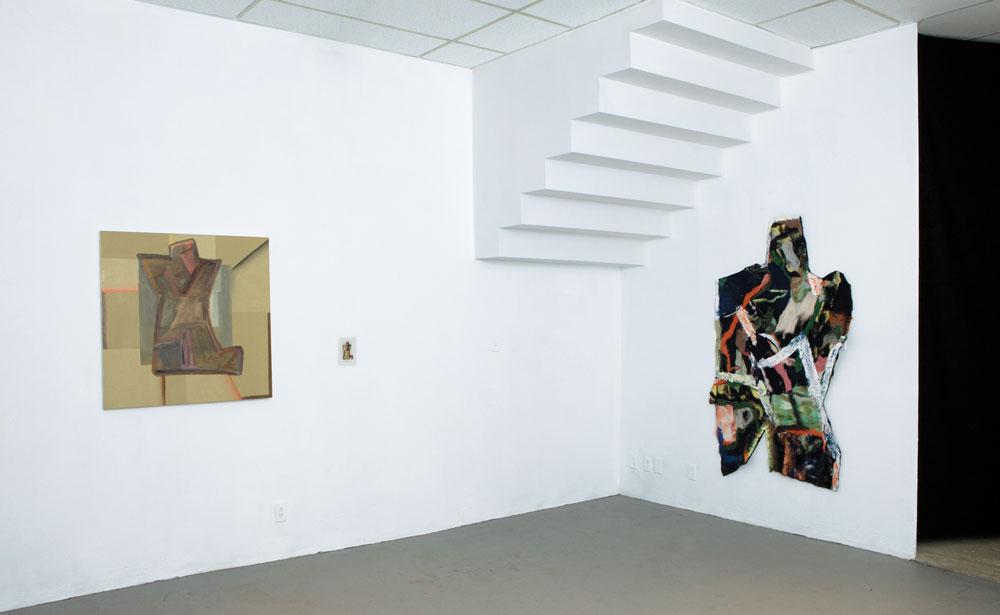In 2011 Rebecca Brewer won the RBC Canadian Painting Competition with a painting called Beuys painting. The title reprised the German conceptualist and performance artist Joseph Beuys sitting in a chair and talking to a dead rabbit, a 1965 performance called How to Explain Painting to a Dead Hare.
That a young painter would want to paint a painting of painting explained seemed promisingly convoluted territory. In his performance Beuys was communing with the ghost of Albrecht Dürer and his painted hare, closing the gap with Germany’s place in Western art. Brewer was doing something similar: communing with Beuys and likewise closing the gap with painting’s relation to conceptualism. The continuity was appealing. Here was a young painter busy with antecedents and legacies, with reattaching to art history. The creams, ochres and greys of her painting were tethered to high analytic Cubism and the figure of the seated Beuys—arm extended either in painting, or writing, or adjusting an optic eyepiece—bore the hieratic dignity of a medieval saint, not St. Jerome, perhaps, but certainly St. Joseph of Düsseldorf.
This past spring Vancouver’s Exercise gallery showed new paintings by Brewer. Robin Anthony, the art consultant for RBC, who keeps a watchful eye on RBC Canadian Painting Competition winners and nominees, had seen them. She sent me an email suggesting I have a look, and after a quick Google search of the gallery’s website I saw a set of impressive installation shots of a series called Nine Paintings of Ayn Rand. Ayn Rand? What was Brewer up to now? Beuys was progressive, cool and countercultural; Ayn Rand was great-aunt to the Tea Party.
I sent Brewer an email trying to draw out an explanation for the homage and for the fact that the Rand paintings possessed the same venerating medievalist groove that the Beuys painting did. After a couple of weeks she emailed back.
“Very sorry for the delay, I’ve been out of town a bit at a cabin in Belcarra Park…I am unfamiliar with Rand other than through secondary and tertiary popular sources, and I decided to remain ignorant to a certain extent while foregrounding my interest in the cloud of visual stuff surrounding her as a figure. I have been interested in early Western religious figuration since I was a teen. The characteristics of the folds of their cloths, the folds themselves conveyers of meaning; similarly, the mudras, the gestures of the hands are so beautifully direct in their codification. It is really difficult to fathom how it could have been expected that these figures could carry and convey the full pathos of an entire religious philosophy, and yet they did.”
They did, indeed. Painters have an affinity for saints and pathos and philosophy, even Ayn Rand’s. Most especially, Brewer’s tuned-in focus on her surrounding “cloud of visual stuff” is the very stuff from which paintings are made.
This is an article from the Winter 2014 issue of Canadian Art. To read more from this issue, visit its table of contents or—to read the entire issue—pick up a copy on newsstands, on the App Store or on Zinio until March 15, 2014. To get every issue of Canadian Art delivered straight to your mailbox, visit canadianart.ca/subscribe.

 From left: Rebecca Brewer, The Dedicated Reader, 2012, oil on panel, 91.5 x 91.5 cm and The Luddite, 2012, wool felt, dry pigment and acrylic, 1.93 m x 101.5 cm. Courtesy the artist/Catriona Jeffries. Photo: Graham Dalik.
From left: Rebecca Brewer, The Dedicated Reader, 2012, oil on panel, 91.5 x 91.5 cm and The Luddite, 2012, wool felt, dry pigment and acrylic, 1.93 m x 101.5 cm. Courtesy the artist/Catriona Jeffries. Photo: Graham Dalik.







